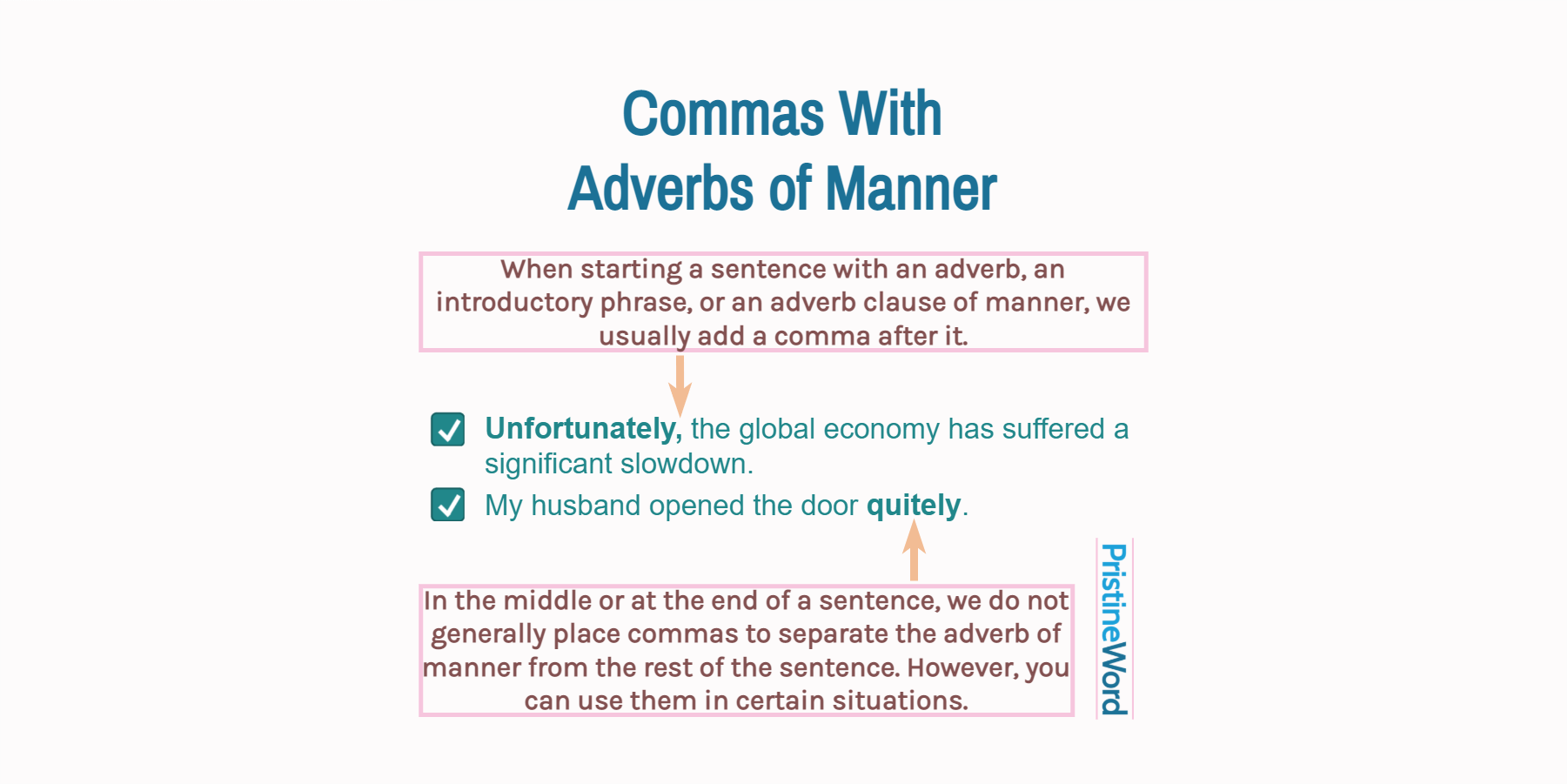When starting a sentence with an adverb, an introductory phrase, or an adverb clause of manner, we often add a comma after it.
When starting a sentence with an adverb, an introductory phrase, or an adverb clause of manner, we often add a comma after it.
Unfortunately, the global economy has experienced a significant slowdown.
In the middle or at the end of a sentence, we do not generally use commas to separate an adverb of manner from the rest of the sentence. However, you can use them to emphasize, add parenthetic information, or signal a strong interruption.
My husband opened the door quietly.
She claimed, sitting with her legs crossed, that her husband had numerous extramarital affairs.
Contents
1. Quick Review of Adverbs of Manner
1.1 The basics
Adverbs of manner describe how you do an action.
She spoke enthusiastically about love.
Peter walked impatiently into the park to meet her.
There are many adverbs of manner. Some of the most commonly used are quietly, slowly, quickly, gently, happily, well, hard, fast, high, sadly, strongly, undoubtedly, etc.
She quietly closed the door.
Children usually recover quickly.
You can also use an adverbial phrase of manner, such as "as quickly as possible", "in a silly way", "in a friendly way", "like a baby", etc., to express how an action is done.
Daniel slept like a baby.
Do your best to interact with people in a friendly way.
Olivia runs like a rabbit.
Steps are being taken to fill those positions as diligently as possible.
1.2 Location
In some cases adverbs of manner follow the verb.
She slept badly last night.
He likes to drive slowly.
But they often go at the end of clauses or sentences.
Patricia speaks Spanish fluently.
Be aware that adverbs of time and adverbs of place frequently go at the end as well. When all three are used, they go in the following order:
- manner
- place
- time
For example:
David plays enthusiastically in the park every Sunday before lunch.
However, adverbs of manner can be moved around in a sentence since they are particularly flexible in this regard.
Slowly and clearly she spoke to her audience.
She spoke slowly and clearly to her audience.
She spoke to her audience slowly and clearly.
2. When to Use a Comma at the Start of a Sentence
Adverbs of manner can:
- function as regular adverbs to describe a single word, usually a verb (e.g., "She spoke clearly.")
- function as sentence adverbs to modify a complete sentence or clause while reflecting the view, opinion, attitude of the writer (e.g., "Sadly, Olivia rejected my kiss."). Another group of sentence adverbs, such us "alphabetically", "religiously", "medically", etc., helps us place a sentence in a particular context (e.g., "Medically, you should treat the patient as soon as possible.")
2.1 Regular adverbs of manner
When using a regular adverb of manner at the start of a sentence, we do not need a comma.
Quickly she ran into the woods.
Optionally, however, you can include it to add emphasis or signal a strong interruption.
Affectionately, we refer to this area as our pocket neighborhood.
2.2 Sentence adverbs of manner
When using a sentence adverb at the beginning of a sentence or clause, add a comma after it. The comma indicates that the adverb of manner describes not the word that follows but the whole sentence or clause that follows.
Unfortunately, I lost contact with her.
Unfortunately I lost contact with her.
2.3 Introductory phrases of manner
You can also start a sentence with an introductory phrase of manner.
Rubbing his chin, he argued that it is possible to perform such a surgery.
Routinely, we should add a comma after an introductory phrase.
Standing around with their arms folded, they declined to participate.
We can drop the comma, however, if the introductory phrase is clear and brief (no more than three or four words).
Opening the door I discovered a beautiful young lady.
3. Commas With Adverbs of Manner in Mid-sentence
We do not typically use commas to set off adverbs of manner in the middle or at the end of a sentence.
It snowed heavily all week.
The audience is listening attentively.
I like to dress casually on Saturdays.
But there are exceptions; for example, you may need to use commas to include nonessential information, signal a pause, or add emphasis.
He cleaned the crime scene, quite meticulously, without being aware of what the witness had seen.

